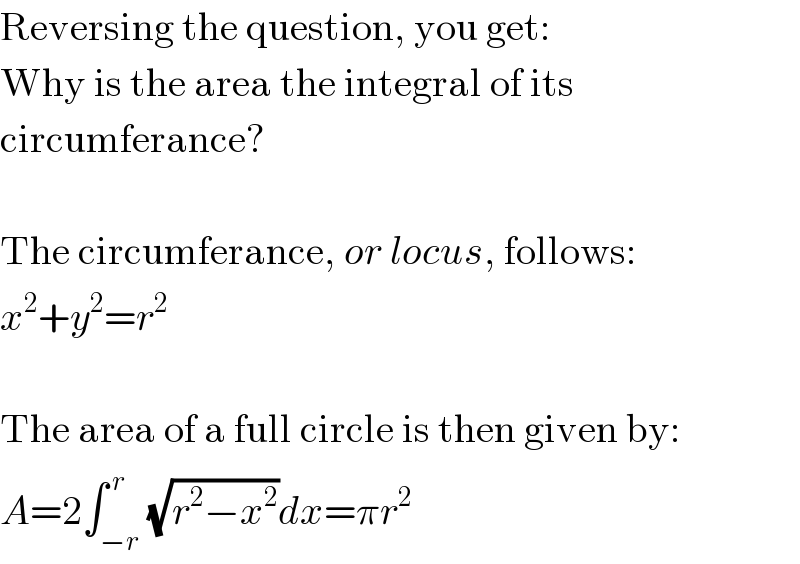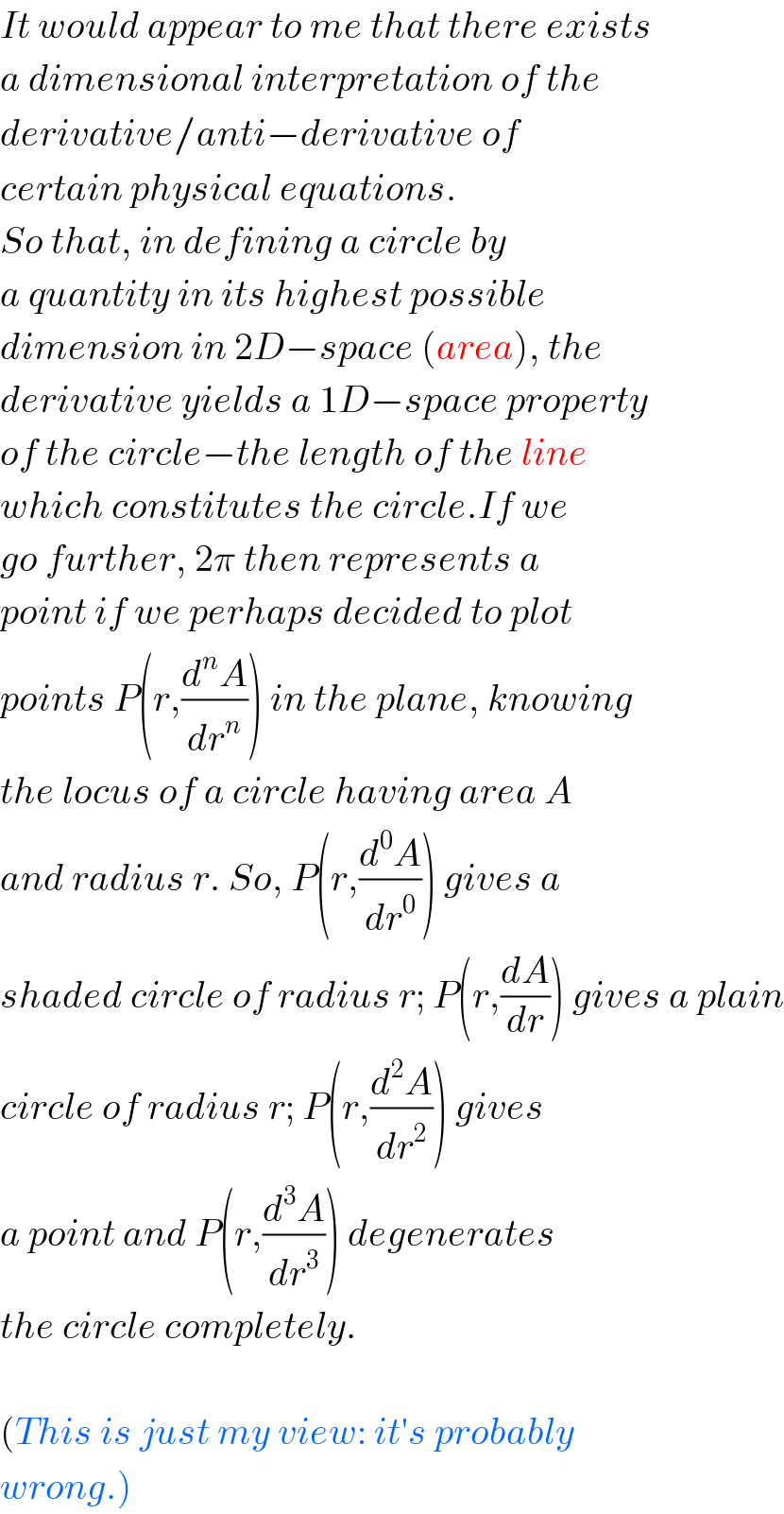
Question Number 3228 by Rasheed Soomro last updated on 08/Dec/15

$$\mathcal{W}{hy}\:{is}\:{circumference}\:{of}\:{a}\:{circle}\:{derivative}\:{of} \\ $$$${its}\:{area}? \\ $$$$\frac{{d}}{{dr}}\left(\pi{r}^{\mathrm{2}} \right)=\mathrm{2}\pi{r}={circumference}. \\ $$
Commented by 123456 last updated on 08/Dec/15

$$\mathrm{it}\:\mathrm{also}\:\mathrm{work}\:\mathrm{to}\:\mathrm{sphere}\:\mathrm{too}\:\left(??\right) \\ $$$$\mathrm{V}=\frac{\mathrm{4}\pi{r}^{\mathrm{3}} }{\mathrm{3}} \\ $$$$\mathrm{S}=\mathrm{4}\pi{r}^{\mathrm{2}} \\ $$
Commented by prakash jain last updated on 08/Dec/15

$$\mathrm{May}\:\mathrm{be}\:\mathrm{it}\:\mathrm{has}\:\mathrm{to}\:\mathrm{with}\:\mathrm{formula}\:\mathrm{related}\:\mathrm{to} \\ $$$$\mathrm{miximum}\:\mathrm{area}/\mathrm{volume}\:\mathrm{given}\:\mathrm{perimeter}/\mathrm{area}. \\ $$
Commented by 123456 last updated on 08/Dec/15

$$\mathrm{isoperimetric}\:\mathrm{inequality}\:\left(\mathrm{or}\:\mathrm{something}\right)? \\ $$
Commented by Filup last updated on 08/Dec/15

$$\mathrm{Reversing}\:\mathrm{the}\:\mathrm{question},\:\mathrm{you}\:\mathrm{get}: \\ $$$$\mathrm{Why}\:\mathrm{is}\:\mathrm{the}\:\mathrm{area}\:\mathrm{the}\:\mathrm{integral}\:\mathrm{of}\:\mathrm{its} \\ $$$$\mathrm{circumferance}? \\ $$$$ \\ $$$$\mathrm{The}\:\mathrm{circumferance},\:{or}\:{locus},\:\mathrm{follows}: \\ $$$${x}^{\mathrm{2}} +{y}^{\mathrm{2}} ={r}^{\mathrm{2}} \\ $$$$ \\ $$$$\mathrm{The}\:\mathrm{area}\:\mathrm{of}\:\mathrm{a}\:\mathrm{full}\:\mathrm{circle}\:\mathrm{is}\:\mathrm{then}\:\mathrm{given}\:\mathrm{by}: \\ $$$${A}=\mathrm{2}\int_{−{r}} ^{\:{r}} \sqrt{{r}^{\mathrm{2}} −{x}^{\mathrm{2}} }{dx}=\pi{r}^{\mathrm{2}} \\ $$
Commented by Rasheed Soomro last updated on 08/Dec/15

$$\:\mathcal{C}{ircumference}\:{here}\:{is}\:{measure}\:{of}\:{circle}\left({locus}\right)\:{not}\: \\ $$$${circle}\:{itself}. \\ $$$$\mathcal{Y}{ou}\:{have}\:{meant}\:{by}\:{circumference}\:{locus}\left({circle}\right) \\ $$$${itself}. \\ $$
Commented by Filup last updated on 08/Dec/15

$${i}\:{see} \\ $$
Commented by Yozzi last updated on 08/Dec/15

$${It}\:{would}\:{appear}\:{to}\:{me}\:{that}\:{there}\:{exists} \\ $$$${a}\:{dimensional}\:{interpretation}\:{of}\:{the} \\ $$$${derivative}/{anti}−{derivative}\:{of}\: \\ $$$${certain}\:{physical}\:{equations}.\: \\ $$$${So}\:{that},\:{in}\:{defining}\:{a}\:{circle}\:{by} \\ $$$${a}\:{quantity}\:{in}\:{its}\:{highest}\:{possible} \\ $$$${dimension}\:{in}\:\mathrm{2}{D}−{space}\:\left({area}\right),\:{the}\: \\ $$$${derivative}\:{yields}\:{a}\:\mathrm{1}{D}−{space}\:{property} \\ $$$${of}\:{the}\:{circle}−{the}\:{length}\:{of}\:{the}\:{line} \\ $$$${which}\:{constitutes}\:{the}\:{circle}.{If}\:{we} \\ $$$${go}\:{further},\:\mathrm{2}\pi\:{then}\:{represents}\:{a} \\ $$$${point}\:{if}\:{we}\:{perhaps}\:{decided}\:{to}\:{plot} \\ $$$${points}\:{P}\left({r},\frac{{d}^{{n}} {A}}{{dr}^{{n}} }\right)\:{in}\:{the}\:{plane},\:{knowing} \\ $$$${the}\:{locus}\:{of}\:{a}\:{circle}\:{having}\:{area}\:{A} \\ $$$${and}\:{radius}\:{r}.\:{So},\:{P}\left({r},\frac{{d}^{\mathrm{0}} {A}}{{dr}^{\mathrm{0}} }\right)\:{gives}\:{a} \\ $$$${shaded}\:{circle}\:{of}\:{radius}\:{r};\:{P}\left({r},\frac{{dA}}{{dr}}\right)\:{gives}\:{a}\:{plain} \\ $$$${circle}\:{of}\:{radius}\:{r};\:{P}\left({r},\frac{{d}^{\mathrm{2}} {A}}{{dr}^{\mathrm{2}} }\right)\:{gives} \\ $$$${a}\:{point}\:{and}\:{P}\left({r},\frac{{d}^{\mathrm{3}} {A}}{{dr}^{\mathrm{3}} }\right)\:{degenerates} \\ $$$${the}\:{circle}\:{completely}. \\ $$$$ \\ $$$$\left({This}\:{is}\:{just}\:{my}\:{view}:\:{it}'{s}\:{probably}\right. \\ $$$$\left.{wrong}.\right) \\ $$
Answered by prakash jain last updated on 08/Dec/15

$$\mathrm{Let}\:\mathrm{us}\:\mathrm{say}\:\mathrm{we}\:\mathrm{try}\:\mathrm{to}\:\mathrm{find}\:\mathrm{out}\:\mathrm{how} \\ $$$$\mathrm{much}\:\mathrm{such}\:\mathrm{curve}\:\mathrm{exists}.\:\mathrm{By}\:\mathrm{the}\:\mathrm{problem} \\ $$$$\mathrm{definition}\:{y}={f}\left({r},{x}\right).\:{where}\:{r}\:{is}\:{an} \\ $$$${independent}\:{parameter}. \\ $$$$\mathrm{Length}\:\mathrm{of}\:\mathrm{a}\:\mathrm{curve}\:\mathrm{L}\left({r}\right)\:=\int_{\mathrm{0}} ^{\:\:{r}} \sqrt{\mathrm{1}+{f}_{{x}} \left({r},{x}\right)^{\mathrm{2}} \:}{dx} \\ $$$${A}\mathrm{rea}\:\mathrm{of}\:\mathrm{curve}\:\mathrm{A}\left({r}\right)=\:\int_{\mathrm{0}} ^{\:{r}} \:{f}\left({r},{x}\right){dx} \\ $$$$\mathrm{The}\:\mathrm{problem}\:\mathrm{statement}\:\mathrm{is}\:\mathrm{find}\:\mathrm{all} \\ $$$${f}\left({r},{x}\right)\:{such}\:{that}\:\mathrm{L}\left({r}\right)=\frac{{d}}{{dr}}{A}\left({r}\right) \\ $$$$\int_{\mathrm{0}} ^{\:{r}} \sqrt{\mathrm{1}+{f}_{{x}} \left({r},{x}\right)^{\mathrm{2}} \:}{dx}=\frac{{d}}{{dr}}\:\int_{\mathrm{0}} ^{\:{r}} \:{f}\left({r},{x}\right){dx} \\ $$$$\int_{\mathrm{0}} ^{\:{r}} \sqrt{\mathrm{1}+{f}_{{x}} \left({r},{x}\right)^{\mathrm{2}} \:}{dx}={f}\left({r},{r}\right)+\int_{\mathrm{0}} ^{\:{r}} {f}_{{r}} \left({r},{x}\right){dx}\:\:...\left({A}\right) \\ $$$$\mathrm{So}\:\mathrm{we}\:\mathrm{need}\:\mathrm{to}\:\mathrm{solve}\:\mathrm{the}\:\mathrm{above}\:\mathrm{equation}\:\mathrm{to} \\ $$$$\mathrm{find}\:{f}\left({r},{x}\right). \\ $$$${f}\left({r},{x}\right)=\sqrt{{r}^{\mathrm{2}} −{x}^{\mathrm{2}} }\:{satisfied} \\ $$$$\sqrt{\mathrm{1}+{f}_{{x}} \left({r},{x}\right)^{\mathrm{2}} }=\sqrt{\mathrm{1}+\frac{{x}^{\mathrm{2}} }{{r}^{\mathrm{2}} −{x}^{\mathrm{2}} }}=\sqrt{\frac{{r}^{\mathrm{2}} }{{r}^{\mathrm{2}} −{x}^{\mathrm{2}} }}=\frac{{r}}{\sqrt{{r}^{\mathrm{2}} −{x}^{\mathrm{2}} }} \\ $$$${f}_{{r}} \left({r},{x}\right)=\frac{{r}}{\sqrt{{r}^{\mathrm{2}} −{x}^{\mathrm{2}} }},\:{f}\left({r},{r}\right)=\mathrm{0} \\ $$$$\mathrm{I}\:\mathrm{will}\:\mathrm{try}\:\mathrm{to}\:\mathrm{find}\:\mathrm{more}\:\mathrm{solution}\:\mathrm{for}\:{A}. \\ $$
